
The northern lapwing, also known as the peewit or pewit, tuit or tewit, green plover, or pyewipe or just lapwing, is a bird in the lapwing subfamily. It is common through temperate Eurosiberia.

Lapwings are any of various ground-nesting birds akin to plovers and dotterels. They range from 10 to 16 inches in length, and are noted for their slow, irregular wingbeats in flight and a shrill, wailing cry.
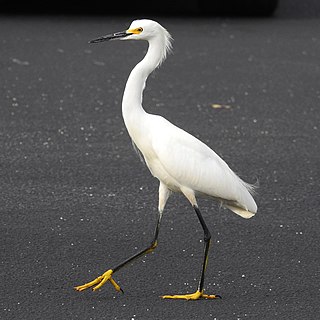
The snowy egret is a small white heron. The genus name comes from Provençal French for the little egret, aigrette, which is a diminutive of aigron, 'heron'. The species name thula is the Araucano term for the black-necked swan, applied to this species in error by Chilean naturalist Juan Ignacio Molina in 1782.

New World orioles are a group of birds in the genus Icterus of the blackbird family. Unrelated to Old World orioles of the family Oriolidae, they are strikingly similar in size, diet, behavior, and strongly contrasting plumage. As a result, the two have been given the same vernacular name.

The yellow-wattled lapwing is a lapwing that is endemic to the Indian Subcontinent. It is found mainly on the dry plains of peninsular India and has a sharp call and is capable of fast flight. Although they do not migrate, they are known to make seasonal movements in response to rains. They are dull grey brown with a black cap, yellow legs and a triangular wattle at the base of the beak. Like other lapwings and plovers, they are ground birds and their nest is a mere collection of tiny pebbles within which their well camouflaged eggs are laid. The chicks are nidifugous, leaving the nest shortly after hatching and following their parents to forage for food.

Anas is a genus of dabbling ducks. It includes the pintails, most teals, and the mallard and its close relatives. It formerly included additional species but following the publication of a molecular phylogenetic study in 2009 the genus was split into four separate genera. The genus now contains 31 living species. The name Anas is the Latin for "duck".

Vanellus is the genus of waders which provisionally contains all lapwings except red-kneed dotterel, Erythrogonys cinctus. The name "vanellus" is Latin for "little fan", vanellus being the diminutive of vannus. The name is in reference to the sound lapwings' wings make in flight.

Panthera atrox, better known as the American lion, also called the North American lion, or American cave lion, is an extinct pantherine cat. Panthera atrox lived in North America during the Pleistocene epoch, from around 340,000 to 12,800 years ago. The species was initially described by American paleontologist Joseph Leidy in 1853 based on a fragmentary mandible (jawbone) from Mississippi; the species name ('atrox') means "savage" or "cruel". The status of the species is debated, with some mammalogists and paleontologists considering it a distinct species or a subspecies of Panthera leo, which contains living lions. However, novel genetic evidence has shown that it is instead a distinct species derived from the Eurasian cave or steppe lion, evolving after its geographic isolation in North America. Its fossils have been excavated from Alaska to Mexico. It was about 25% larger than the modern lion, making it one of the largest known felids.

Cowbirds are birds belonging to the genus Molothrus in the family Icteridae. They are of New World origin, and are obligate brood parasites, laying their eggs in the nests of other species.

The southern lapwing, commonly called quero-quero in Brazil, or tero in Argentina and Uruguay, tero-tero in Paraguay, and queltehue in Chile is a wader in the order Charadriiformes. It is a common and widespread resident throughout South America, except in densely forested regions, the higher parts of the Andes, and the arid coast of a large part of western South America. This bird is particularly common in the basin of the Río de la Plata. It has also been spreading through Central America in recent years. It reached Trinidad in 1961, Tobago in 1974, and has rapidly increased on both islands, sporadically making its way North to Barbados where one pair mated, nested, and produced chicks in 2007.
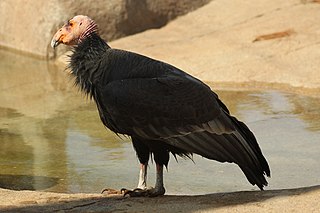
Gymnogyps is a genus of New World vultures in the family Cathartidae. There are five known species in the genus, with only one being extant, the California condor.
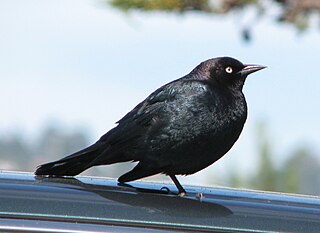
Euphagus is a small genus of American blackbirds. It contains two extant species: Brewer's blackbird, Euphagus cyanocephalus, and rusty blackbird E. carolinus.
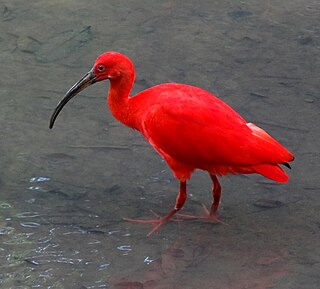
Eudocimus is a genus of ibises, wading birds of the family Threskiornithidae. They occur in the warmer parts of the New World with representatives from the southern United States south through Central America, the West Indies, and South America.

Glossotherium is an extinct genus of large mylodontid ground sloths of the subfamily Mylodontinae. It represents one of the best-known members of the family, along with Mylodon and Paramylodon. Reconstructed animals were between 3 and 4 metres long and possibly weighed up to 1,002.6–1,500 kg. The majority of finds of Glossotherium date from the Middle and Upper Pleistocene, around 300,000 to 10,000 years ago, with a few dating older, as far back Pliocene, about 3.3-3 million years ago. The range included large parts of South America, east of the Andes roughly from latitude 20 to 40 degrees south, leaving out the Amazon Basin in the north. In western South America, finds are also documented north of the equator. The animals largely inhabited the open landscapes of the Pampas and northern savanna regions.

The pied plover, also known as the pied lapwing, is a species of bird in the family Charadriidae. It is a bird of least concern according to the IUCN and can be found in northern South America. The species name cayanus refers to Cayenne, the capital of French Guiana, where the pied plover can be found.

The long-toed lapwing , also known as the long-toed plover, is a species of wading bird in the lapwing subfamily, within the family Charadriidae. It is mainly sedentary and found across central and eastern Africa, from Chad and South Sudan in the north to Mozambique in the southeast of its range. It is one of 13 species of ground-nesting lapwings found in Africa.
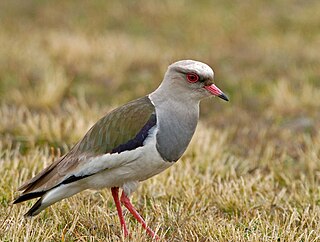
The Andean lapwing is a species of bird in family Charadriidae, the plovers and their relatives. It is found in Argentina, Bolivia, Chile, Colombia, Ecuador, and Peru.

Milvago is a genus of bird of prey in the family Falconidae.
Paleontology or palaeontology is the study of prehistoric life forms on Earth through the examination of plant and animal fossils. This includes the study of body fossils, tracks (ichnites), burrows, cast-off parts, fossilised feces (coprolites), palynomorphs and chemical residues. Because humans have encountered fossils for millennia, paleontology has a long history both before and after becoming formalized as a science. This article records significant discoveries and events related to paleontology that occurred or were published in the year 1979.
The convex-billed cowbird is an extinct species of bird in the family Icteridae, described in 1947 by Alden H. Miller. It is the only member of its genus, Pandanaris.




















